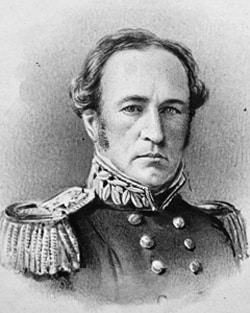Robert Patterson was a Major General in the Union Army during the American Civil War. He is remembered for an early victory over Stonewall Jackson and the failure to stop P.G.T. Beauregard and Joseph Johnston from joining forces during the First Battle of Bull Run.

He, along with Irvin McDowell, became one of the scapegoats for the Union's defeat.
Jump to:
Early Life
Patterson was born in Cappagh, County Tyrone, Ireland. His family was banished from Ireland due to his father's involvement as an insurrectionist. In 1799, he emigrated to the United States, where he eventually became involved in banking at a young age.
Patterson received his education in public schools and afterward became a clerk in a Philadelphia counting house. He volunteered for service during the War of 1812 and rose from captain to colonel in the 2nd Pennsylvania Militia before joining the United States Army.
He served in the Quartermaster General Department and was discharged in 1815 as a captain.
After the war, Patterson returned to commercial pursuits in manufacturing and established several mills. He became influential in politics in Pennsylvania. Patterson was one of the five Col. Pattersons in the Pennsylvania Convention that nominated Andrew Jackson for the presidency and, in 1836, was President of the Electoral College that cast the vote for Martin Van Buren.
Patterson served as the Commander of the Pennsylvania State Militia. In 1838, he led troops to end the Anti-Abolition Riots in Philadelphia, which led to the destruction of Pennsylvania Hall.
Again, in 1844, he helped to put down the Philadelphia Bible Riots against Irish Catholics, which resulted in the destruction of St. Michael's and St. Augustine's Churches. The first riot took place in Kensington in May.
Another took place in Southwark in July. On each occasion, Gen. Patterson led militia into combat with rioting civilians, leading to loss of life on both sides.
Mexican-American War Service
Patterson was commissioned as a major general of volunteers at the outbreak of the Mexican–American War and commanded the 2nd Division, Army of Occupation, during the Tampico Expedition. He was considered for command of the expedition to Veracruz, which eventually went to Winfield Scott.
He was, however, placed in command of the expedition's Volunteer Division and saw action during the Siege of Veracruz and at the Battle of Cerro Gordo, where he was wounded. He led the American pursuit of the Mexican Army and was the first to enter Jalapa. While the U.S. Army was stationed at Jalapa, Patterson returned to the U.S. with other volunteer units whose enlistment time had expired. He then resumed his business interests in Pennsylvania, where he acquired 30 cotton mills and became quite wealthy.
Patterson became one of the largest mill owners in the United States and was heavily involved in sugar refineries and cotton plantations. He again was an influential figure in Philadelphia politics.
Civil War
After distinguishing himself during the Mexican-American War, Patterson became a well-known military figure throughout the United States. When the Civil War broke out, he would again be called in to serve his country, but this time his service would not be so distinguished.
He was appointed major general of Pennsylvania volunteers and commanded the Department of Pennsylvania and the Army of the Shenandoah. In 1861, Winfield Scott gave Patterson orders to retake Harper's Ferry. Patterson was hesitant to make the move, and his slow action led to him being outmaneuvered in the Battle of Hoke's Run.
Joseph Johnston then marched to the First Battle of Bull Run and reinforced P.G.T. Beauregard without any deterrence. Johnston did, however, declare that Patterson’s army had largely deterred him from pursuing the shattered and disorganized Union troops as they retreated back to Washington after the battle.
Patterson, widely criticized for his failure to contain the enemy forces, was mustered out of the Army in late July 1861.
This would be the end of Patterson's military career. His career finished in an unspectacular fashion when he was embarrassed by Confederate generals.
Life After Military
Robert Patterson retired from the military after a long and distinguished career. He wrote the book A Narrative of the Campaign in the Valley of the Shenandoah in 1861 and lived quietly the rest of his life.
Patterson died in Philadelphia and is buried there in Laurel Hill Cemetery.
His son, Francis Engle Patterson, and his son-in-law, John Joseph Abercrombie, were both Union generals during the Civil War.
Patterson's mansion was located on the southwest corner of 13th and Locust Streets.
After Patterson’s death in 1881, the Historical Society of Pennsylvania purchased the mansion as its permanent home. The mansion was demolished between 1905 and 1909, and a new building was dedicated in 1910.
